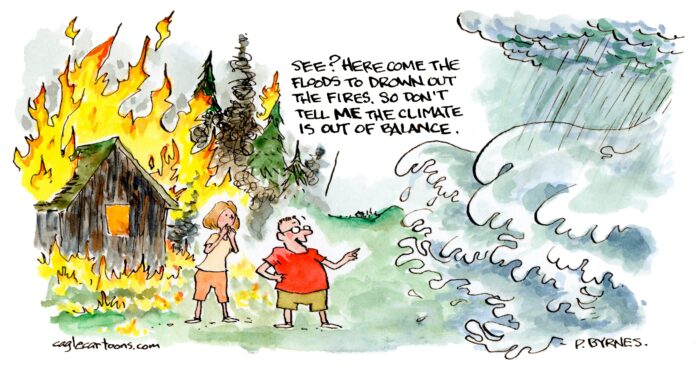I don’t need personal connections to awaken my concern for our warming planet and the dangers that it creates. But that doesn’t stop Mother Nature from occasionally grabbing me by the shoulders and shaking the complacency out of me.
Two of my favorite places and another that impressed me on my only visit made climate news recently – sorta.
A Sept. 27 fire in the Bighorn Mountains of Wyoming burned throughout October, scorching almost 100,000 acres. Another fire, starting on the Wichita Mountains Wildlife Refuge, topped out at about 12,500 scorched acres. A freak downpour in Roswell, N.M., flash-flooded the entire town.
The catastrophes devastated their areas, and received local news coverage. But fly-over America seldom registers on the national radar.
There are rock formations – such as a ski-nosed Dick Nixon – and stands of aspens that I regard as familiars if not friends. Heck, I set a dramatic trilogy in a fictionalized Dayton 40 years ago and am still refining a Bighorns Suite song cycle that I started a few years back. I hold that part of the country close to my heart.
So, I spent most of last month more than miffed that such a large, destructive fire received zilch national coverage.
The Wildlife Refuge is an oasis of natural wonders for southwestern Oklahoma. Of course, since it is in southwestern Oklahoma, I limit my explorations to the cooler months. In fact, last summer’s heat was so brutal that Refuge rules ruled out hiking after 10 a.m. for weeks at a time.
Granted, the Rush Fire was smallish by wildfire standards. But having made a special viewing of Rush Lake the week prior before visiting the also-affected Holy City made that fire very personal.
State/church separatist that I am, I am no fan of federal property serving to advance any religious beliefs. But I do think the painted ceiling at the little church there is pretty cool.
Of shorter duration, but with more devastating human impacts, the Roswell flash flood disaster resulted from 5.78 inches of rain falling over five hours, breaking a record that had stood 123 years. The deluge overwhelmed the city drainage system. The water had nowhere to go but up, “washing away cars, submerging buildings and leaving much of the city under a layer of silt,” according to Danielle Prokop of Source NM.
Adan Levya told KRQE reporters that the scope of the flooding was hard to believe: “This is sad we have a bunch of businesses. Our entrance to our historic art and everything, it just got ruined. So it is pretty, pretty sad, it is pretty sad seeing this.”
Two people died in the flooding and more than 500 had to be rescued, including more than 100 people who found shelter on the roof of the Roswell Convention and Civic Center, where a quinceañera became memorable for all the wrongs reasons.
Damage estimates in Roswell’s Chaves County reached $500 million by the end of October.
Citing Michael Coleman, a spokesman for New Mexico Gov. Michelle Lujan Grisham, Prokop reported: “New Mexico is one of many states experiencing more frequent and severe disasters stemming from climate change.”
Coleman said, “The more of these events we experience as a state, and as a nation, the more our collective resources for responding will be stretched thin. We must fortify our infrastructure and make it more resilient against damaging and sometimes catastrophic weather events.”
In July Dr. Twila Moon, a climatologist and deputy lead scientist at NASA’s National Snow and Ice Data Center told Salon, “Along with this warming, we see increases in deadly heat waves and droughts, but also an increased experience of ‘global weirding,’” which she characterized as “more extreme weather events producing conditions that are entirely new for communities, weather whiplash as folks may experience quick swings between hot and cold or drought and flood, and many challenges for crops, wildlife, recreation, and being able to plan for what we previously considered normal weather conditions.”
I can attest to the heat and drought in southwestern Oklahoma. The Northern Rockies, too, were hotter than normal all summer. Roswell exemplifies the “global weirding,” receiving half of its yearly precipitation in one storm.
Yet, two major, climate-induced incidents in fly-over America received no national coverage. There are just too many global warming disasters hitting us too often for down-sized media forces to keep pace. They are still trying to grasp the extent of the damage from Hurricane Helene.
And each of those areas clobbered extra hard as the result of our greed-led inaction in dealing with our warming planet are more than very special memories to those who call them home.







